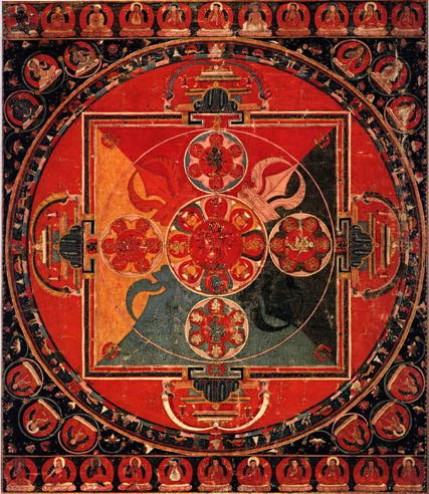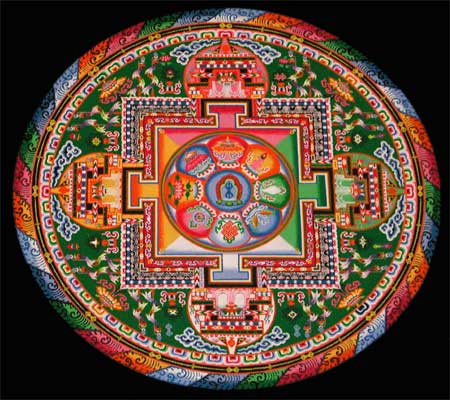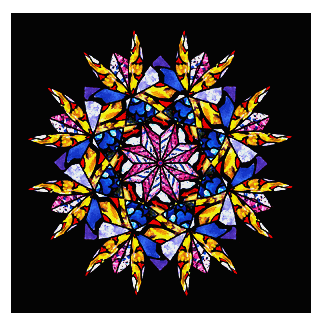Tibetan Buddhist Mandalas In Tibet, the process of creating a Mandala is as important as the finished product. It takes years of preparation and training to gain the skill and knowledge required painting. Even when one is able to begin, meditation for three days must occur before a brush can be put to canvas. According to the legend, the founder of Tibetan Buddism, Padmasambhava was born in a lake in a lotus blossom. The Padmasambhava Lake is considered to have the clearest blue color of all the lakes in the world and to hold strong healing power. One of the means of the Tibetan Buddhists to gain freedom is meditation on sublime thoughts and pictures. Such a picture is the Mandala. There are many types of Mandalas in Tibet. In Tibetan Buddhism the figure has the significance of a ritual instrument (yantra), whose purpose is to assist meditation and concentration. The first type is recognized by its sinister images of fire, dragons and warriors. The overall impression is one of dynamic energy. In contrast, the "cosmic fortress" creates a visual safe place, filled with gods, goddesses, lotus and angelic beings. They are there to protect and bless us as we tune into that center within ourselves. The Mandala is often illustrated as a palace with four gates, facing the Four Corners of the Earth. |  |
The wired Mandala meditation toy is knows in India and Tibet and used to meditate, to let one loose himself in a state of spiritual immersion. Today, mandala has also been widely known as a creative play, which is excellent in developing the talent of children; older people can use it also for relaxation but many see it as a specific jewel to be worn as a bracelet or hair ornament. |
Sand Mandalas Of all the artistic traditions of Tantric or Tibetan Buddhism, painting with coloured sand ranks as one of the most unique and exquisite. In Tibetan, the art is called dul-tson-kyil-khor, which means "mandala from coloured powders". To construct the mandala, millions of grains of sand will be painstakingly laid into place on a flat platform. The mandala is a formal geometric pattern representing the floor plan of a sacred mansion. The actual construction begins with the drawing of the design on the base. The artists measure out and draw the architectural lines using a straight-edge ruler, compass and white ink pen. Once the diagram is laid out, coloured sand is applied to the mandala through the end of a metal funnel, known as a chang-bu. The most common substance used in the creation of a dul-tson-kyil-khor is white marble that has been ground and then dyed. Other popular substances are powdered flowers, herbs or grains, as well as powdered and coloured stones. Intricate patterns reflect many levels of understanding. The design is ritually prepared over a period of days, then blown away to represent the impermanence of life. The sand, which has been blessed throughout the process, is seen to benefit the land and rivers it comes in contact with. Tibetans believe that a sand Mandala contains the knowledge to achieve enlightenment in this lifetime. The creation of a sand painting is said to effect a purification and healing. In his commentary on the empowerment ceremony of the Guhyasamaja Tantra, the Seventh Dalai Lama (1708-1757) wrote: "Empowerment can be accomplished on the basis of a drawn or painted mandala, a mandala made of coloured powders or sands, or a mandala created through meditation." The artists begin from the inside of the design and work outward, to symbolize how at birth a child is just a drop of sperm and ovum, and then steadily grows, until eventually the entire universe becomes experienced through the senses. When eventually the Mandala has been completed and its purpose served, the time for dismantling it has arrived. The sands are swept up from the outside toward the center, thus symbolizing how in old age and at the time of death everything once more returns to the primordial source at the center of the heart. Prior to dismantling the mandala, another ceremony is performed, giving thanks to the local spirits for their cooperation, and dedicating any meritorious energy that has been generated to the fulfillment of universal benefit, healing and peace. The sands are swept up and carried in a vase to a nearby body of water, where they are deposited. Placing the sands in water, which by nature is connected to all the waters of the world, symbolizes the dedication of the positive energies of the mandala process to universal goodness. In addition to symbolizing the impermanence of things, the dismantling of the mandala symbolizes the ultimate voidness nature of phenomena: how all things come out of nothingness and eventually return to it. |  |
Mandalas in the West There is also a tradition of healing circles in the west. Powerful symbolism is seen in Native American sand paintings, medicine wheels and shields. Medicine wheels represent the universe, change, life, death, birth and learning.The great circle is the lodge of our bodies, our minds and our hearts. Although there are many parallels to the Tibetan Mandala, Native Americans never used the word Mandala to describe their sacred circles. In Europe, Hermetic Mandalas, though usually linear, may also be circular. Alchemy, the Kabbalah, geometry and numerology play an important part of their design and creation. In his book "The Western Mandala", Adam Mc Clean writes: "Mandalas can be seen as keys that unlock the mysteries of our soul's architecture. If we choose to use them in this way, they can lead us deep into the mysteries of our inner world." The architecture of Gothic cathedrals shows another way towards illumination. |  |